Boeing and the Royal Australian Air Force (RAAF) have successfully flown two MQ-28 Ghost Bat uncrewed aircraft controlled by a single operator onboard an E-7A Wedgetail, simulating a live engagement with an airborne target.
The mission, conducted at Woomera, South Australia, marks the first time two MQ-28 aircraft, plus a third digital twin, were operated from an airborne platform, validating a key concept for collaborative combat aircraft (CCA) systems.
Glen Ferguson, director of MQ-28 Global Programs at Boeing, said the trial demonstrated a significant advancement in operational integration:
“This trial demonstrates family-of-systems integration, the strength of our open systems architecture, and is a critical first step towards integrating mission partners’ software and communications systems natively into the E-7A Wedgetail.”
He added: “It not only validated a key element of the MQ-28 concept of operations, but also how collaborative combat aircraft can expand and enhance the role of the E-7A to meet future force requirements.”
The MQ-28 Ghost Bat, developed in Australia, is designed to fly autonomously or in support of crewed aircraft, offering enhanced reach, survivability, and sensor coverage. The trial involved the use of software jointly developed by Boeing Defence Australia, the Defence Science and Technology Group, and the U.S. Air Force Research Laboratory.
Australian Minister for Defence Industry Pat Conroy MP welcomed the achievement, saying:
“The Ghost Bat has the potential to turn a single fighter jet into a fighting team, with advanced sensors that are like hundreds of eyes in the sky.”
The test forms part of Capability Demonstration 2025 (CD25), a wider campaign of RAAF operational tests exploring how uncrewed platforms like the MQ-28 will integrate with Australia’s existing air combat fleet. Future demonstrations will include coordination with F/A-18F Super Hornet and F-35 aircraft.
Adam Tsacoumangos, director of Air Dominance Programs at Boeing’s Phantom Works, added:
“It has been an exceptional collaborative effort across organisations from government, contractors, and global partners.”



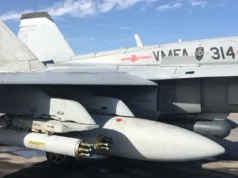

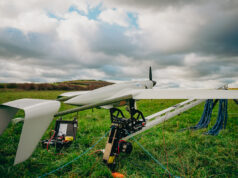
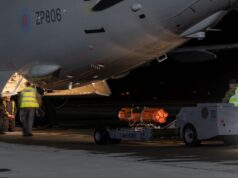
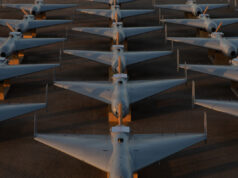
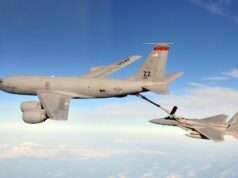
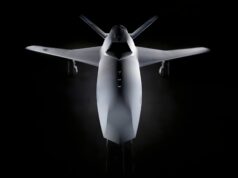

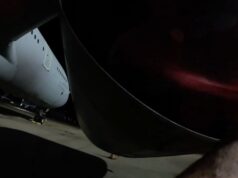
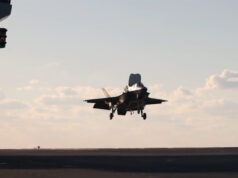

Are we now seeing a future shift in air combat, large strategic range aircraft running mother to a large swarm of drones.. I did once read a paper that proposed the future of human crewed aircraft was larger strategic platforms and the more tactical element.. single seat fighters.. would be replaced by drones controlled by the large strategic platforms.
Yes, this very much seems more useful than the loyal wing man concept. It never seemed to make any sense to have drones following fighter jets. However a large control aircraft surrounded by a swarm of these providing extended sensor coverage and weapons employment seems much more sensible.
You could for example see one do these over the UK with several drones providing QRA coverage.
This will only work if the drones can be controlled from long range. Wedgetail would be almost as vulnerable to SAM attack as the 737 airliner on which it is based. It can’t manoeuvre quickly and relies solely on chaff and flares.
Indeed and you would want a stealthy platform..with good sensors. The assumption is the aircraft with the most resources will in the end win and bigger planes have more resources,, more powerful sensors, with bigger apatures, more processing power, more weapons and drones etc.
Wedgetail defence doesn’t rely entirely on chaff and flares. It has EW defenses and some party tricks. Remember it MESA radar is arguably the most powerful radar in the sky and because it’s electronically steered it can focus the beam on a very small area.
Wedgtail also is fitted with DIRCM Directed Infrared Countermeasures that uses a laser to confuse infrared guiding missiles and/or engage the missile with the laser.
Quite.
People really underestimate the potency of electronic defences or what a high powered radar really can do to a target close….if you apply 200kW of microwave energy [you home microwave is ~2kW] to an electronic system what do you think happens…..then add that that will be modulated to set up eddy currents…..it isn’t just about blinding the system…..high energy RF can be very destructive.
As we saw when Russian missiles were fired at a RIVET they ‘mysteriously’ malfunctioned and dropped from the sky…
Add in the potential AA capabilities of some of the drones. An AA missile fired from the ground (SAM) that has the range to hit an E7 won’t be small. Any fighter attacking an E7 has the problem of that massive MESA radar. Sneaking up on it will be hard. Drones armed with something like the in development Raytheon miniature active radar AA missile should be able to attack the shooter or the missile (in the case of a long range SAM), all directed by the E7 with the MESA radar & up to 10 human operators using high end workstations. All that before the E7 resorts to its onboard defences.
There have been cases in the West Pacific where fighters have annoyed P8 aircraft (including releasing chaff in front of the aircraft). Doing that to an E7 would be in advisable.
@ Jonathan.
Let’s hope they won’t switch to using crewed large aircraft.
“We ain’t got none.”
I like this platform, given the Aussies are buying T26 and Aukus, perhaps we should buy this in high volumes as an UOR. We could do worse and it give us mass. There’s a lot to like about this approach as it’s COTS and available now, they are also doing a lot of legwork for us and we are in 5 eyes together
Be interesting if the mother shio could piggy back the Ghost bat till close to area of operations ( or refuel).
Distance / range / endurance is an Australian challenge unless you fwd base the drones in several locations with mothership flying to different areas of interest as required.
Ghost Bat doesn’t need to piggy back – it has a range of 3,700 kms for a combat radius of 1,500 kms
In Australia that combat radius gets you to the next city !
LOL So true. That’s basically just Brisbane to Sydney.
Fly to London transiting over Darwin from any eastern seaboard Australian capital city and you’ll spend more than your first four hours in the air without leaving Australian airspace.
Sometimes I wonder if the UK missed outside the box thinking. We need AEW aircraft, we also need ASW/Maritime aircraft not to forget the need for air to air refueling aircraft and to finish of air motherships.
Although the E7 Wedgetail looks like a good AEW platform would it also be able to control a flight of UAVs control a air combat situation and ground control if needed. To stay on station it need a tanker, if its working over the sea a P-8 is still needed.
So if we took all of these requirements and combine them into one aircraft we could be on to something.
To start with we need some large airframe, preferably Airbus A330-800 or dare I say A380, then we take the fuel system from A330 MRTT with both boom and drouge systems and install. Yes I know its not plug and play but Airbus would know how to take an existing fuel delivery system and install it into one of their airframes. We have two E-7 radar suites available I am sure that the Airbus engineers can work out the aerodynamics to install the main radar. So now we have a tanker with E-7 capability and able to refuel its escorting fighters. Now comes the future ability a six station control for loyal wingmen and long range UAVs. Strangly enough from the technical aspect this is not to difficult as it is just a two way high speed data link but the issue is the linking of information from the AEW system and the UAV network. For the final piece of the tasking would be ASW, again six-eight stations would be needed and bays for sonar bouys +weapons as well as some strengthening of the wing roots and extra hard points under the wings. The final part would be to have a area for a full replacement crew for rest sleep and eat.
Yes these aircraft would be expensive. Or would they? As I have said it apears that we have two E-7 radar suites somewhere, A-380s are going for £18mill used on the open market, much of the design work on the refueling systems is done it just needs redesigning for the aircraft type, the technical work for the P-8 maritime/ASW suite is done it just needs reworking into a bigger airframe. So much of the tech is done it just needs to be put together. If someone says yes but. I will scream, many of you on this site know I am ex signals, I learnt not to say no, but how can we do it. it can be done you just need a team to think outside the box.
The concept for these aircraft is not to have them in areas of potential close quater combat but to patrol the region Bergan-Shetlands-Faroe Island-Iceland-Greenland. To see air threats from 800km whilst at the same time to monitor the sea on or below. This would aid UK GBAD, RN anti submarine patrols and possibly a carrier strike group if they ever need to go up north. By placing one of these aircraft 800km NNE of the Faroes you cover the air to air AEW detection from Navrik to Greenland. If we the UK used the AN/APY-10 Multi-Mission Maritime and Overland Surveillance Radar it would give the P-8 a 200 nm range surface search capability. If we ever did think about building a airborne area control platform they could even now operate with the MQ-4C Triton, Sea/Sky Guardian, MQ-28 Ghost Bat, be able to control and refuel every manned combat aircraft in NATO, whilst being able to pass data fire control to every warship in NATO.
Now comes the final issue how many do we need? So if these aircraft did a air to air refueling that would reduce time on station. So we could start with the non air to air time on statio with a full fuel load. That would be 1.5 hours to get to station, 10 hours on station and 1.5 hours to fly back. So for 24 hour per day you will need 3 aircraft on on station one getting ready and one in case of failure. Then you would need three more aircraft one in deep maintance, one in ready maintance and one on the flight line. So a total of six. Now combine these six with two Sea Guardians and two Sky Guardians each, Sea Guardian withing 100km range port Starb. of the multi mission control aircraft and Sky Guardian 200 km forward port starb at 45degrees of the nose the area of the Norwegian seas and any threat coming from the North would be seen. So the multi mission control aircraft as a single unit is expensive, but as a forward deployed picket line able to do many tasks it is cost effective.
That sounds a lot but lets look at what we have now, a E-7 would take 1.5 hours to get to the same region for the same coverage but 4 hours on station. If we want to extend that we need to ask a nation with a boom on the tanker for help. Then if there is no help 2.5 hours later a second E-7 would need to take off. To cover the same area for maritime/ASW a second P-8 would need to operate. Whoops a daisy we need help from or friends for more tanker support. Now we have two strategicaly important aircraft up in the north with no support so we need to send fighter cover but 800 km from land they need a tanker.
So now you have a E-7, P-8, MRTT, fighters and four times the numbers due to time on station and a much more complicated communication system.
Many will say I am day dreaming or talking rubbish. However, if you look at the specs of the current aircraft, look at the tasks that they will carry out in war then maybe you will understand what I am thinking.
Ghost Bat doesn’t need to piggy back – it has a range of 3,700 kms for a combat radius of 1,500 kms
In answer to your question would the E7 be able to manage a flight of Ghost Bats and still manage the air combat tasking for fighter jets the answer is yes.
That’s effectively what this exercise is working towards. Remember the Ghost Bat is designed to operate autonomously – it can be remotely piloted but it doesn’t need to be. It can be assigned a mission and use its AI to complete it.
Also all 10 workstations on the E7 are identical. Any one of the 10 or more than one can be controlling drones like Ghost Bat. There is I believe, options to increase the number of consoles if required. E7 was designed to control the battle space. It was what it was built for. Aircraft like the F35 only has the pilot. Doesn’t strike me as the best option as a drone controller. Human overload is a real thing. Aircraft like F/A18F can have a dedicated operator. But the E7 can be controlling its own Ghost Bats, while also directing the F18F which is also controlling its own Ghost Bats.
I don’t know how USAF is going to do this with an E2D.
Agree that the E7 is the best platform for controlling large numbers of drones, however the two seat FA18G Growler with its standoff anti radiation missiles and teamed with a couple of drones will have particular utility in jamming, spoofing or destroying SAM systems iike the S300 and S400. It’s the kind of SEAD/DEAD missions the RAAFs Growlers already practice at Red Flag but drones (particularly Ghost Bat with its modular swappable sensor/payloads) opens up a whole new set of potential TTPs.
While “Growlers” are a bit of a special case (agree with your assessment), I think pretty well all 2 seater fighter versions are potentially excellent drone controllers. Some of these are often used for conversion training, but may find a new unexpected role (especially if said fighter is fully combat capable – ASEA radar etc).
One of the potential problems I see with Ghost Bat sized drones is in the ground attack role. I lot of these weapons are quite heavy & drones tend to be rather load constrained. Missiles like Hellfire & Brimstone can get expensive for the basics. Does anyone know if the BAE Razer is fast jet capable?
I agree the cost of the bits is peanuts.
The cost of screwing it together would be significant.
The cost of certifying it would be enormous.
The cost of certifying mods to two unique frames would be unbelievable. This is the bit people miss. Because of Haddon Cave we, rightly, have a proper system for this.
There is zero appetite in the UK for another NIMROD AEW / MRA4 type of budget eating adventure.
If more funds appear I’d go for more E7 and P8 with auxiliary drones.
If there was money in the kitty I’d add AAR to our existing tankers.
Both E7 and P8 have crew facilities, toilets, galley and space to rest and rotate crews. They are, after all, commercial frames that naturally have these things certified by the manufacturer.
I would also point out that the E7 has maritime (surface) ability. P8 is surface & sub surface.
I agree.
There is considerable overlap between the platforms.
The same MRTT as used by UK exists with both boom & drogue refuelling on the one aircraft. All certified, already in service.
We don’t make such platforms because they would simply be far to complex and expensive and very very maintenance heavy. Voyagers do carry some substantial communication equipment and datalinks. But not on the scale you are talking about. Nice idea. But it won’t happen.
Replace the “large airframe” with a semi-autonomous dirigible and stick the people part in a room on the mainland..
1/ You have to have considerable power generation to power high end sensors like massive radars.
2/ Unless you have fibre optic connections, your ‘on the mainland’ controllers have severe bandwidth restrictions which will limit what they can see & do. Unlike an E3, an E7 is looking everywhere at the same time. It generates a massive amount of data.
3/ The MESA radar is not the only sensor on an E7. So even more bandwidth required.
All of that goes away if you simply use an E7.